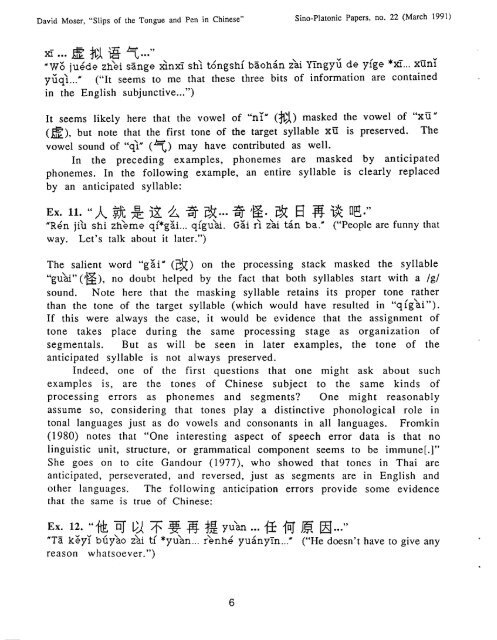Slips of the Tongue and Pen in Chinese - Sino-Platonic Papers
Slips of the Tongue and Pen in Chinese - Sino-Platonic Papers
Slips of the Tongue and Pen in Chinese - Sino-Platonic Papers
Create successful ePaper yourself
Turn your PDF publications into a flip-book with our unique Google optimized e-Paper software.
David Moser, "<strong>Slips</strong> <strong>of</strong> <strong>the</strong> <strong>Tongue</strong> <strong>and</strong> <strong>Pen</strong> <strong>in</strong> Ch<strong>in</strong>ese"<br />
fi BBB $A<br />
T..."<br />
S<strong>in</strong>o-<strong>Platonic</strong> <strong>Papers</strong>, no. 22 (March 199 1)<br />
" ~ 6<br />
ycqi ..." ("It seems to me that <strong>the</strong>se three bits <strong>of</strong> <strong>in</strong>formation are conta<strong>in</strong>ed<br />
<strong>in</strong> <strong>the</strong> English subjunctive...")<br />
jdde zhii s3nge &nxi shi t6ngshi baoh<strong>in</strong> z'ai Y<strong>in</strong>gyc de yige *fi... xT<strong>in</strong>i<br />
It seems likely here that <strong>the</strong> vowel <strong>of</strong> "ni" ($"A) masked <strong>the</strong> vowel <strong>of</strong> "xD"<br />
(B), but note that <strong>the</strong> first tone <strong>of</strong> <strong>the</strong> target syllable XU is preserved. The<br />
vowel sound <strong>of</strong> "$" (7) may have contributed as well.<br />
In <strong>the</strong> preced<strong>in</strong>g examples, phonemes are masked by anticipated<br />
phonemes. In <strong>the</strong> follow<strong>in</strong>g example, an entire syllable is clearly replaced<br />
by an anticipated syllable:<br />
Ex. 11. "A 3 2 2 /L 3 & ...~)~. & @ 1 .<br />
"RQ~ jih shi zh\eme qi4g:i ... qigu'ai. G% r? z'ai t6n ba." ("People are funny that<br />
way. Let's talk about it later.")<br />
'A [g 7,<br />
The salient word "g'ii' (&) on <strong>the</strong> process<strong>in</strong>g stack masked <strong>the</strong> syllable<br />
"gu'ai"(~F), no doubt helped by <strong>the</strong> fact that both syllables start with a /g/<br />
sound. Note here that <strong>the</strong> mask<strong>in</strong>g syllable reta<strong>in</strong>s its proper tone ra<strong>the</strong>r<br />
than <strong>the</strong> tone <strong>of</strong> <strong>the</strong> target syllable (which would have resulted <strong>in</strong> "qigki").<br />
If this were always <strong>the</strong> case, it would be evidence that <strong>the</strong> assignment <strong>of</strong><br />
tone takes place dur<strong>in</strong>g <strong>the</strong> same process<strong>in</strong>g stage as organization <strong>of</strong><br />
segmentals. But as will be seen <strong>in</strong> later examples, <strong>the</strong> tone <strong>of</strong> <strong>the</strong><br />
anticipated syllable is not always preserved.<br />
Indeed, one <strong>of</strong> <strong>the</strong> first questions that one might ask about such<br />
examples is, are <strong>the</strong> tones <strong>of</strong> Ch<strong>in</strong>ese subject to <strong>the</strong> same k<strong>in</strong>ds <strong>of</strong><br />
process<strong>in</strong>g errors as phonemes <strong>and</strong> segments? One might reasonably<br />
assume so, consider<strong>in</strong>g that tones play a dist<strong>in</strong>ctive phonological role <strong>in</strong><br />
tonal languages just as do vowels <strong>and</strong> consonants <strong>in</strong> all languages. Fromk<strong>in</strong><br />
(1980) notes that "One <strong>in</strong>terest<strong>in</strong>g aspect <strong>of</strong> speech error data is that no<br />
l<strong>in</strong>guistic unit, structure, or grammatical component seems to be immune[.]"<br />
She goes on to cite G<strong>and</strong>our (1977), who showed that tones <strong>in</strong> Thai are<br />
anticipated, perseverated, <strong>and</strong> reversed, just as segments are <strong>in</strong> English <strong>and</strong><br />
o<strong>the</strong>r languages. The follow<strong>in</strong>g anticipation errors provide some evidence<br />
that <strong>the</strong> same is true <strong>of</strong> Ch<strong>in</strong>ese:<br />
EX. 12. u~ 7 3 $$ $$yu'an ... fl a am..,,<br />
"TZ kgyi bGy'ao hi ti *y u'an ... r'enhe yuby<strong>in</strong> .' ("He doesn't have to give any<br />
reason whatsoever.")
















